Fructose-1,6-biphosphate in rat intestinal preconditioning: involvement of nitric oxide
- PMID: 11156636
- PMCID: PMC1728195
- DOI: 10.1136/gut.48.2.168
Fructose-1,6-biphosphate in rat intestinal preconditioning: involvement of nitric oxide
Abstract
Background and aims: Inhibition of glyceraldehyde-3-phosphate dehydrogenase (GAPDH) by nitric oxide (NO) in intestinal preconditioning could modify the rate of formation of glycolytic intermediates. Fructose-1,6-biphosphate (F16BP) is a glycolytic intermediate that protects tissue from ischaemia/reperfusion injury. We evaluated if F16BP may be endogenously accumulated as a consequence of GAPDH inhibition by NO during intestinal preconditioning in rats.
Methods: We assessed: (1) effect of preconditioning on F16BP content; (2) effect of NO on GAPDH activity before and during sustained ischaemia; and (3) protective effect of F16BP in control, ischaemic, and preconditioned animals with or without administration of N-nitro-L-arginine methyl ester (L-NAME), NO donor, or F16BP.
Results: Preconditioned rats showed a significant transient decrease in GAPDH activity and also maintained basal F16BP levels longer than ischaemic rats. L-NAME administration to preconditioned rats reversed these effects. F16BP administration to ischaemic rats decreased protein release in the perfusate. Administration of F16BP to L-NAME treated rats attenuated the harmful effect of L-NAME.
Conclusions: Our study indicates that F16BP may be endogenously accumulated in preconditioned rats as a consequence of inhibition of GAPDH by NO, and this may contribute to the protection observed in intestinal preconditioning.
Figures
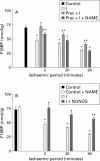
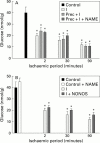
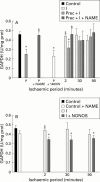
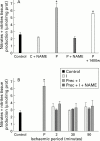
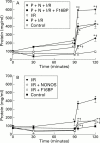

Similar articles
-
Modification of glyceraldehyde-3-phosphate dehydrogenase in response to nitric oxide in intestinal preconditioning.Transplantation. 1999 Jun 15;67(11):1446-52. doi: 10.1097/00007890-199906150-00010. Transplantation. 1999. PMID: 10385084
-
CO2 in static mesenteric venous blood during intestinal ischemia and ischemic preconditioning in rats.Shock. 2001 Nov;16(5):403-8. doi: 10.1097/00024382-200116050-00015. Shock. 2001. PMID: 11699082
-
Promising effects of ischemic preconditioning in renal transplantation.Kidney Int. 2002 Jun;61(6):2218-27. doi: 10.1046/j.1523-1755.2002.00360.x. Kidney Int. 2002. PMID: 12028463
-
Role of nitric oxide in resveratrol-induced renal protective effects of ischemic preconditioning.J Vasc Surg. 2005 Dec;42(6):1198-205. doi: 10.1016/j.jvs.2005.08.032. J Vasc Surg. 2005. PMID: 16376214
-
Fructose 1,6-Bisphosphate: A Summary of Its Cytoprotective Mechanism.Curr Med Chem. 2016;23(39):4396-4417. doi: 10.2174/0929867323666161014144250. Curr Med Chem. 2016. PMID: 27758716 Review.
Cited by
-
Ubiquitin-proteasome system and oxidative stress in liver transplantation.World J Gastroenterol. 2018 Aug 21;24(31):3521-3530. doi: 10.3748/wjg.v24.i31.3521. World J Gastroenterol. 2018. PMID: 30131658 Free PMC article. Review.
-
Role of changes in tissular nucleotides on the development of apoptosis during ischemia/reperfusion in rat small bowel.Am J Pathol. 2002 Nov;161(5):1839-47. doi: 10.1016/S0002-9440(10)64460-4. Am J Pathol. 2002. PMID: 12414530 Free PMC article.
